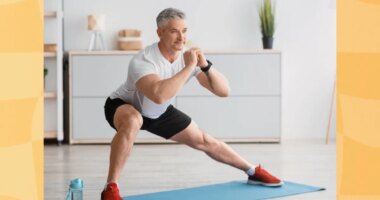Getting older can be a fabulous and fortunate experience—especially as you fully appreciate and enjoy your body as it changes. That certainly applies to the ways you work out. While exercise can help keep you healthy as you age, it’s also best to know what kind of physical activities will benefit your body the most and help you avoid potential issues or injuries. We’ve put together the best exercises to do every decade of your life, so listen up.
Whether you’re in your 20s, 30s, 40s, 50s, or 60 and older, you’ll want to check out the following exercises from Melissa Kendter, an ACE-certified trainer, running coach, and functional training specialist with EvolveYou. Kendter has a passion for helping people of all ages and fitness levels find the best fitness journeys for them. So keep reading to learn about the top-recommended exercises to do every decade of your life, according to a fitness pro.
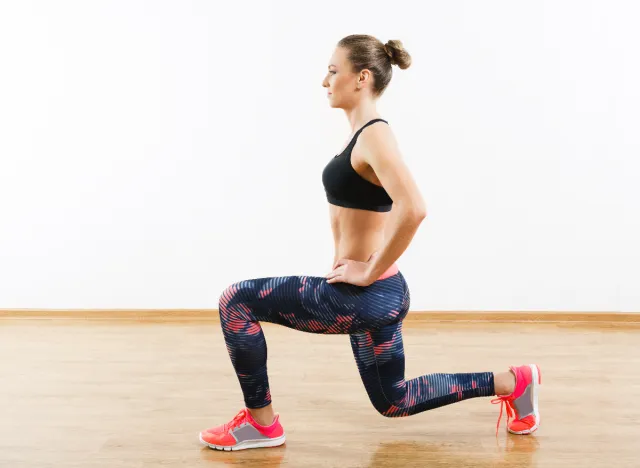

“Starting young, you want to keep your muscles, joints, and total body strong,” Kendter tells Eat This, Not That!, adding, “Incorporating dynamic compound exercises will be beneficial to building a strong base that will follow you into every stage of your life.” First up in our list of exercises to do every decade of your life is the walking lunge in your 20s.
Kendter explains this exercise will help you develop unilateral leg function and strength, boost leg hypertrophy, and “bridge the gap” between movement in the real world and strength training during your workouts. Even though walking lunges are on the more challenging side, this exercise will be well worth adding to your routine. Get ready to give your hip mobility, range of motion, and glute development a solid boost.
In order to perform walking lunges, start with your feet shoulder-width distance apart. Step forward with one foot into a lunge, and pause for a moment. Then, move your other foot up to meet the one in front before stepping forward into another lunge. Continue this movement, alternating between legs. Aim for three 30-to-45-second sets.
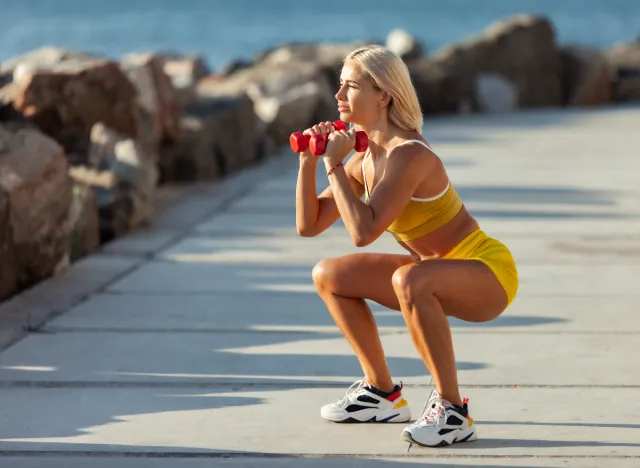

When it comes to being in your 30s, Kendter explains, “[This is a time when] we are settling into life and our work which may lead us to become more sedentary, so you want to make sure you are targeting your entire body, incorporating strength and cardio movements.”
With that in mind, Kendter suggests doing dumbbell thrusters. She favors this exercise because it simultaneously activates some major muscle groups, including your core, your upper body, and your posterior chain. She also explains that this compound movement will give you the “maximum bang for your fitness buck,” because it helps sculpt muscle, build strength, and torch body fat.
To get started, hold a dumbbell in each hand. Position the weights up by your shoulders and beside your ears. As for your feet, position them shoulder-width distance apart. When you’re in the proper position, lower into a squat. Then, rise back up to standing, and press the dumbbells up over your head, completely extending your arms. Return back to the position you started in. Aim for three sets of eight to 12 reps.
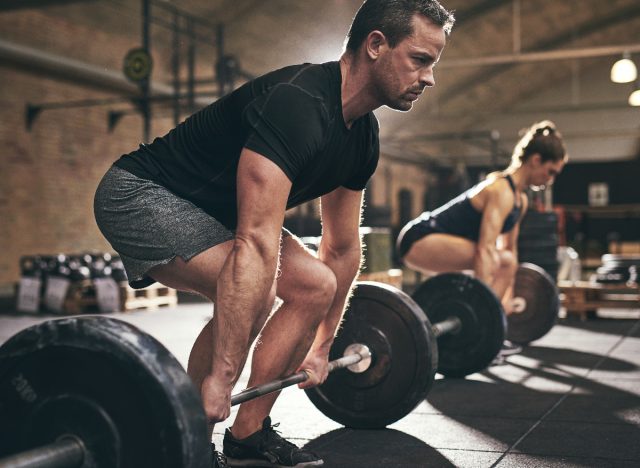

Deadlifts may have an intimidating name, however, Kendter says they happen to be “a time-efficient way to build and maintain muscle, specifically in the posterior chain, [which includes the] entire backside from your calves and glutes to your upper back!”
READ RELATED: 6 Signs Your Anger Issues Would Benefit From Therapy, According to Experts
As you age, you may adopt more sedentary habits. This can lead to weak glute muscles and poor posture. Kendter explains, “The deadlifts are highly effective at increasing functional strength due to the activation of your largest muscles, strengthen your entire backside, improve posture, and train you for the functional activity of safely lifting objects off of the floor, which is a key skill for remaining strong at life.”
While a deadlift is often done with a barbell, you can also hold a dumbbell in each hand. Begin with your feet shoulder-width distance apart and the weights on the floor. Bend down to grab onto the barbell (or the dumbbells). While keeping your back straight, lift the weight up until you’re in a standing position. Pause before lowering the weight back down to the floor. Aim for three sets of six to 10 reps.
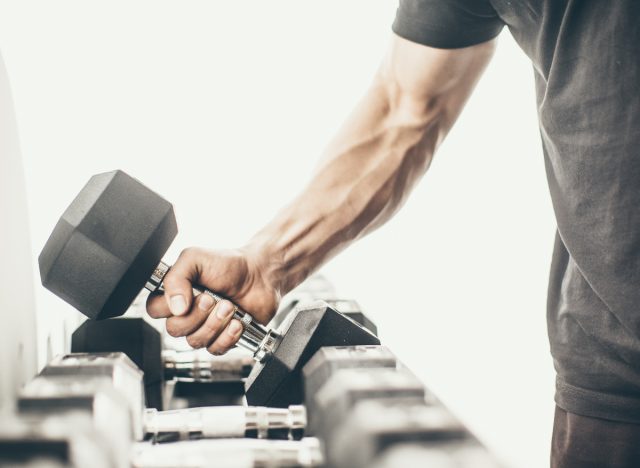

By the time you reach your 50s, Kendter says your balance and coordination may begin to decline, so it’s crucial to focus on functional exercises to maintain strong bones and good balance. She also points out, “From carrying packages to moving your couch, or just bringing the groceries in, carrying loads are a part of our daily lives and it’s important to have the confidence to do so without any anxiety of getting hurt or simply being unable to do them.”
That’s why Kendter recommends performing loaded carries as part of your workout at this age and stage of life. She continues to explain, “[They] target your entire body from your gait, core, glutes and more. They offer a great deal of benefits, specifically to further develop strength, athleticism, balance, and injury prevention.” This functional movement improves your ability to perform everyday tasks and even the activities you do for fun.
To perform loaded carries, simply grab a dumbbell, and walk forward to a certain distance that you find challenging but not overwhelming. Once you’ve reached the endpoint, put down the weight, and rest. Then, go again. Aim to walk for 45 seconds each time in sets of three. In order to truly see the benefits of this physical activity, remember that the goal is to go heavier and keep up proper form.
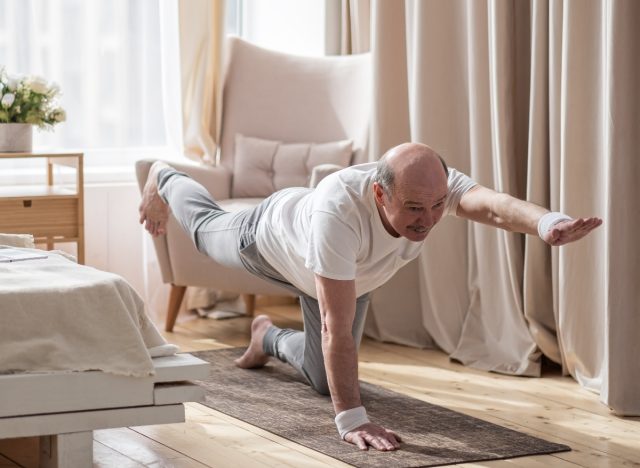

“As we get into our 60s and 70s, we want to make sure we are continually working on our balance, mobility, and posture,” Kendter explains, adding, “Around this time, we see more hip and joint issues arising, so being able to move fluidly is key.”
Enter, the bird dog. While it sounds like a hybrid critter, it’s actually an exercise that utilizes your entire body to strengthen the hips, core, back, and glutes muscles. In addition, this exercise promotes good posture, enhances your range of motion, and relieves lower back pain.
To perform bird dogs, carefully get onto the floor before positioning yourself on your hands and knees. When you’re stable, lift one arm up and point it out in front of you. If you’re able to, also lift the opposite leg, and point it out behind you. Then, bring both your arm and leg back into the starting position. Next, do the same movement with the other arm and leg. Kendter advises you to aim for three sets of 12 to 15 reps on each side, however, listen to your body, and do fewer if that’s enough of a challenge.
Source:





